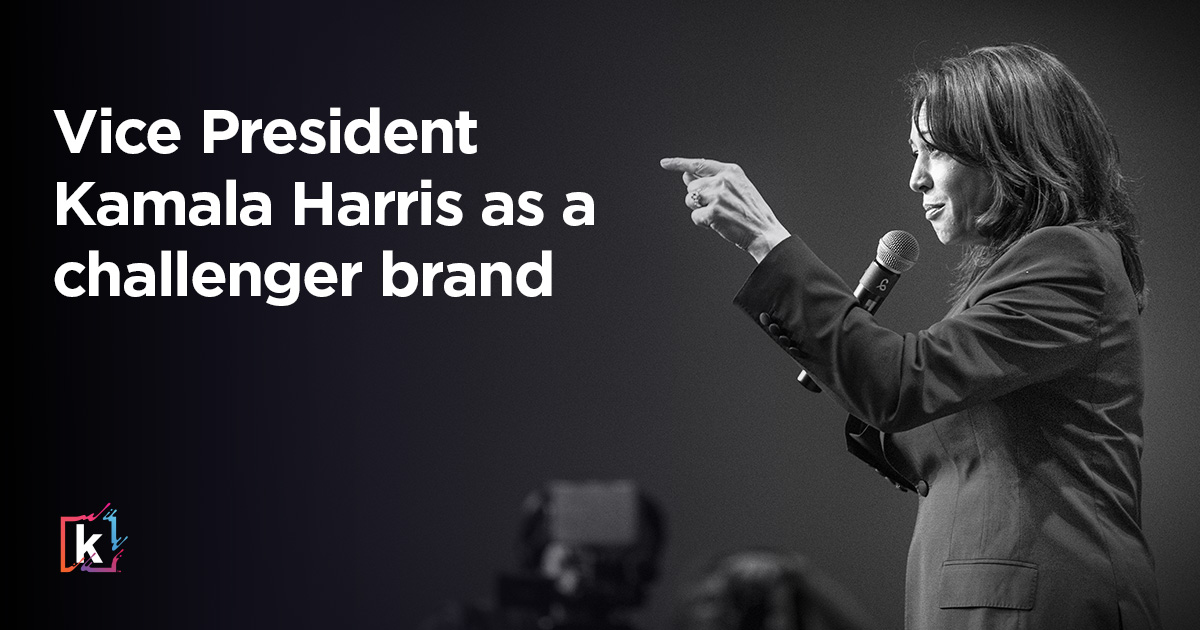Navigating the 2024 Political Landscape: Vice President Kamala Harris’ Challenger Brand Perspective


The 2024 election cycle is shaping up to be one of the most critical in recent U.S. history, with a political landscape marked by shifting voter demographics, emerging issues, and the growing influence of social media. Candidates are not merely vying for votes; they are fiercely competing to establish and strengthen their personal brands in an environment where authenticity, relatability, and adaptability are paramount. Vice President Kamala Harris, the sitting vice president and current Democratic-nominee for President, finds herself in a unique position as she maneuvers through the challenges of defining her brand amidst a turbulent political field.
Despite being a well-established figure, Vice President Harris embodies the characteristics of a challenger brand—a brand that must continuously innovate and differentiate itself to capture the attention of a diverse electorate. This blog explores how Harris is recalibrating her brand strategy as she eyes the presidency. We will explore the marketing tactics she employs and extract valuable lessons that can be applied by brands, specifically challenger brands, navigating similarly competitive landscapes.
Are you a Dope Thinker? Those who elevate categories, products, people, experiences, and culture through diverse and inclusive thinking.
Show your support for Vice President Kamala Harris with exclusive Dope Thinkers for Kamala merch here.
Emphasizing Authenticity in Messaging
In today’s world, authenticity is more than a buzzword; it’s a fundamental expectation. Voters and consumers alike are drawn to figures and brands that present themselves as genuine and relatable. (See Cardi B, Nene Leakes, and yes, former President Donald Trump). Harris has strategically incorporated her personal story into her public persona, making her not just a politician, but a symbol of lived experiences that resonate with many Americans.
Marketing Tactic:
Harris’ speeches and public appearances are often blended with stories from her upbringing, her mother’s influence, and her career as a prosecutor and senator. For example, in her speeches, she frequently references her mother’s activism and how it shaped her worldview. This approach isn’t just about humanizing herself; it’s a deliberate effort to create an emotional connection with her audience– making her policies and stances feel more grounded and accessible.
Lessons for Marketers:
- Authenticity Builds Trust: In a marketplace where consumers are consistently presented with (read bombarded) with choices, trust becomes a deciding factor. Brands that communicate with authenticity are more likely to earn the trust and loyalty of their audience. Just as Harris uses her life story to build credibility, brands can leverage their origins, values, and customer stories to create a sense of trustworthiness.
- Personal Narratives Make Complex Concepts Relatable: Vice President Harris’ ability to link her policies to personal experiences helps demystify complex political issues, making them more relatable to the average voter. Similarly, brands can use storytelling to explain their products or services, breaking down complicated features into relatable benefits that resonate with the consumer’s everyday life.
- Consistency in Messaging Reinforces Brand Identity: Harris consistently ties her messaging back to her core identity, ensuring her brand remains cohesive across various platforms and appearances. For marketers, this consistency is crucial in building a recognizable and dependable brand. Every piece of content and every campaign should reflect the brand’s core values and identity to strengthen its overall position in the market.
Leveraging Social Media to Drive Engagement
In the digital age, social media is not just an add-on to a campaign strategy; it’s a vital component that can make or break a brand’s connection with its audience. Harris has demonstrated a keen understanding of this– using social media to both engage with her base and reach new demographics. Her campaign’s use of platforms like Twitter, Instagram, and TikTok highlights the importance of being present where the audience is most active.
Marketing Tactic:
Harris’ social media strategy is multifaceted. On Instagram, her campaign often shares behind-the-scenes content that provides a glimpse into her day-to-day activities, making her more relatable to followers. On X, her team quickly responds to trending topics, ensuring that her voice is part of the broader conversation. Meanwhile, TikTok is used to engage younger voters with short, impactful videos that align with the platform’s dynamic nature. For example, her campaign’s TikTok videos often feature her speaking directly to the camera in a casual setting, discussing policy in a way that feels personal and approachable.
Lessons for Marketers:
- Meet Your Audience Where They Are: Harris’ campaign understands that different demographics prefer different platforms. By tailoring content for each platform—whether it’s the brevity of X, the visual appeal of Instagram, or the viral nature of TikTok—her campaign ensures that it reaches voters where they are most likely to engage. Marketers should adopt a similar approach, identifying where their target audience spends time online and creating content that is native to those platforms.
- Engagement is a Two-Way Street: Social media is not just about broadcasting messages; it’s about creating dialogue. Harris’ campaign makes a point to respond to comments, engage in conversations, and even address criticism in a constructive manner. For brands, this level of engagement can build stronger relationships with customers, turning casual followers into brand advocates. It’s important to listen as much as you speak in the social media space.
- Visual Content and Short-Form Videos are Essential: In an era dominated by rapid consumption of content, visual storytelling is key. Harris’ use of short-form videos on TikTok and visually appealing posts on Instagram exemplifies how important it is to capture attention quickly and effectively. Brands should invest in high-quality visual content and consider the growing popularity of video content to ensure their messages are not only seen but remembered.
Adapting to Changing Voter Priorities
Further, the political landscape is a reflection of the broader societal context, which is constantly evolving. Successful political campaigns, much like successful brands, must be agile, adapting their messaging to reflect the current priorities of their audience. Harris’ campaign has demonstrated this adaptability by shifting its focus as voter concerns have changed over time.
Marketing Tactic:
As the 2024 campaign unfolds, Harris’ messaging has increasingly centered on issues that resonate with voters in the current socio-economic climate. For instance, in response to growing concerns about economic inequality and the rising cost of living, her campaign has highlighted her plans for economic reform, including raising the minimum wage and supporting small businesses. This shift shows her ability to pivot her messaging to align with the most pressing issues facing voters today, thereby remaining relevant and engaging.
Lessons for Marketers:
- Flexibility is Key to Relevance: In a world where consumer preferences and societal norms can shift rapidly, flexibility in messaging is crucial. Harris’ ability to adapt her campaign to focus on the issues that matter most at any given moment demonstrates the importance of being nimble. Brands must be prepared to pivot their messaging and strategies in response to changes in the market or consumer sentiment, ensuring that they remain relevant.
- Understanding Your Audience’s Evolving Needs: Harris’ campaign illustrates the importance of staying attuned to the changing priorities of her audience. Through research, data analysis, and direct engagement, her team can adjust their strategy to reflect what voters care about most. For brands, this means constantly monitoring consumer behavior, market trends, and feedback to understand how needs and preferences are evolving, and then tailoring offerings accordingly.
- Data-Driven Insights Inform Strategic Pivots: Successful adaptations are often informed by data. Harris’s campaign likely uses polling data, social media analytics, and other research methods to gauge voter sentiment and adjust messaging accordingly. Brands should similarly leverage data to make informed decisions, whether it’s through customer feedback, market research, or digital analytics. By grounding strategic pivots in data, brands can ensure that changes align with audience expectations and market opportunities.
Vice President Harris’ approach to navigating the 2024 political landscape as a challenger brand offers a wealth of insights for marketers. Her emphasis on authenticity, strategic use of social media, and ability to adapt to changing voter priorities are not just political strategies—they are brand-building lessons that can be applied across industries.
For marketers, the key takeaways are clear: prioritize authenticity in all communications, meet your audience where they are by using the right platforms and content types, and remain flexible, ready to adapt to changing market dynamics. These principles are not only essential for political campaigns, but are also vital for any brand looking to build a strong, lasting connection with its audience.
As the election cycle continues, Harris’ brand strategy will undoubtedly evolve– providing even more lessons for those watching closely. Whether in the context of politics or business, the ability to resonate with your audience, engage meaningfully, and adapt to change will always be the hallmarks of a successful brand.

